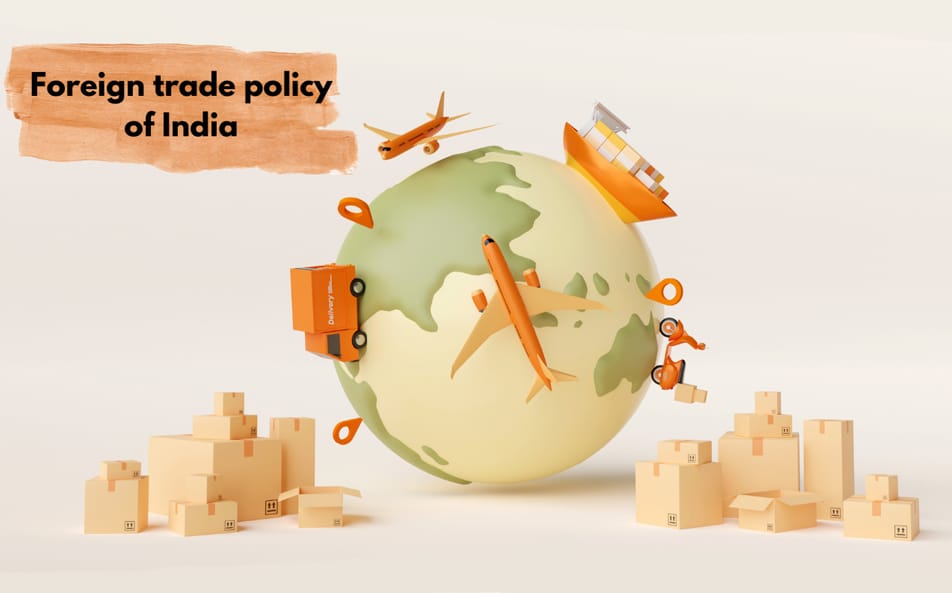Table of Contents
ToggleIndia’s Foreign Trade Policy 2025: Roadmap to a $2 Trillion Export Economy
India’s Foreign Trade Policy (FTP) 2025, unveiled by the Ministry of Commerce and Industry, marks a strategic shift from incentive-driven trade to a digitally empowered, sustainability-focused framework. Designed to propel India toward its $2 trillion export target by 2030, this policy addresses evolving global challenges while reinforcing domestic manufacturing under the Atmanirbhar Bharat initiative. Let’s dissect its key features, objectives, and implications.
Background: From FTP 2015-20 to the 2025 Vision
India’s previous FTP (2015–20), extended until March 2023, prioritized export diversification and employment generation under the Make in India campaign. However, geopolitical disruptions, supply chain volatility, and the urgency to decarbonize trade necessitated a dynamic overhaul. FTP 2025 builds on its predecessor’s pillars—Incentive to Remission, Ease of Doing Business, Export Promotion via Collaboration, and Emerging Areas—while integrating green initiatives and digital governance.
Key Objectives of FTP 2025
- Export Promotion & Market Diversification
- Target $2 trillion in exports by 2030, focusing on untapped markets in Africa, Latin America, and ASEAN.
- Expand the RoDTEP (Remission of Duties and Taxes on Exported Products) scheme to cover sectors like pharmaceuticals and green hydrogen.
- Digitalization & Trade Facilitation
- 100% paperless approvals via the DGFT portal, reducing processing times for Advance Authorizations and EPCG licenses from 7 days to 24 hours.
- AI-driven risk management systems for faster Customs clearance and SCOMET compliance.
- Sustainability & Green Trade
- Incentivize exports of electric vehicles, wastewater treatment systems, and renewable energy equipment.
- Mandate carbon footprint disclosure for high-emission sectors by 2026.
- MSME Empowerment
- Slash application fees for MSMEs by 60% under the Advance Authorization Scheme.
- Launch Udyog Sahayog, a digital platform for MSMEs to access global trade data and logistics support.
Major Highlights of FTP 2025
- Streamlined Schemes for Exporters
- Advance Authorization Scheme: Now includes apparel exports, allowing duty-free imports of raw materials on self-declaration.
- EPCG Scheme: Reduced export obligations for green tech imports (e.g., solar panels, EV components) by 25%.
- One-Time Amnesty Scheme: Settle pending export obligations by paying 100% of exempted customs duties, resolving ₹8,500 crore in legacy disputes.
- Sector-Specific Interventions
Sector | Key Measures |
Agriculture | Double exports of organic spices and millets by 2027 via cluster-based farming. |
Electronics | Extend PLI benefits to semiconductor manufacturers under the Make in India initiative. |
Textiles | Integrate PM MITRA parks with EPCG’s Common Service Provider Scheme. |
- Digital Governance Upgrades
- Automatic IT Approvals: 55+ permissions, including IEC issuance, now automated3.
- e-Certificate of Origin (CoO): Self-certification for Status Holders, cutting processing time from 5 days to 2 hours.
Evolving Trade Strategy: From FTP 2015–20 and FTP 2023 to the New FTP 2025
India’s Foreign Trade Policy 2025 represents a strategic shift from the earlier export policies — FTP 2015–20 and the interim version of 2023. While the older policies were fixed in duration and scope, FTP 2025 introduces a progressive, adaptive model designed to evolve with emerging global and domestic trade dynamics.
Unlike the rigid five-year cycle of FTP 2015–20 or the temporary measures under FTP 2023, the new policy framework is open-ended and real-time, enabling regular revisions based on stakeholder feedback, global trade trends, and geopolitical shifts.
Policy Period | Core Characteristics | Evolutionary Focus |
FTP 2015–20 | Static 5-year cycle, export promotion schemes | Broad-based export incentives and sectoral support |
FTP 2023 | Interim update with simplified compliance | Emphasis on digitization, automation, and amnesty relief |
FTP 2025 | Dynamic and perpetual model | Deeper digital integration, sustainability, faster redressal |
This forward-looking policy is structured to help India realize its $2 trillion export target by 2030, offering a more agile, technology-driven, and export-friendly trade environment for businesses of all sizes — particularly MSMEs and emerging exporters.
Impact Analysis: Boosting Exports, Bridging Deficits
- Trade Deficit Reduction: RBI’s March 2025 bulletin notes a narrowed deficit (3.4% of GDP) due to rising services exports and lower commodity imports.
- MSME Growth: Simplified norms could boost MSME export share from 48% to 60% by 2026.
- Global Positioning: Strategic FTAs with the EU and Australia aim to counter China’s dominance in electronics and critical minerals.
Challenges & Concerns
- Implementation Hurdles: State-level delays in infrastructure projects and skill gaps in adopting digital tools.
- Global Headwinds: US-China tariff wars could shave 0.6% off global GDP growth, affecting Indian exports.
- WTO Compliance Risks: Subsidy caps under WTO’s Agreement on Agriculture may limit farm export sops.
Conclusion: Aligning with a Self-Reliant India
FTP 2025’s blend of tech-driven agility and green imperatives positions India as a global trade powerhouse. By focusing on MSMEs, sustainability, and strategic FTAs, the policy aligns with the Atmanirbhar Bharat vision while navigating geopolitical flux. Success hinges on seamless execution—states must upgrade logistics, and industries must adopt ESG norms. As global trade rewires, India’s 2025 playbook offers a template for resilient, inclusive growth.
FAQs on Foreign Trade Policy of India 2025
- What is the Foreign Trade Policy (FTP) 2025 and why is it significant for India?
The Foreign Trade Policy of India 2025 is the government’s official framework to regulate and promote India’s international trade. It adopts a dynamic, open-ended approach, focusing on digitization, ease of doing business, and sustainability to help India achieve its ambitious $2 trillion export target by 2030. - How does FTP 2025 differ from previous policies like FTP 2015-20 and FTP 2023?
Unlike the fixed-term FTP 2015-20 and the interim FTP 2023, FTP 2025 is a flexible, continuously updated policy. It emphasizes enhanced digital processes, sustainability, and streamlined procedures, making it more responsive to global trade shifts and domestic priorities. - What are the main objectives of FTP 2025?
Key objectives include boosting exports in India, diversifying export markets and products, promoting digitalization and trade facilitation, and encouraging sustainability and green trade practices. The policy also aims to empower MSMEs and startups to participate in global trade. - What are the FTP 2025 highlights and major schemes for exporters?
Major highlights include the continuation and expansion of schemes like RoDTEP and Advance Authorization, simplified procedures via the DGFT online portal, sector-specific support (agriculture, services, manufacturing), and special initiatives for MSMEs and e-commerce exports. - How does FTP 2025 support MSMEs and new exporters?
FTP 2025 reduces application fees for MSMEs, introduces digital platforms for trade facilitation, and offers targeted support through schemes and export hubs. These measures aim to increase MSME participation in exports and simplify their compliance requirements. - What role do Free Trade Agreements (FTAs) play in India’s trade strategy for 2025?
FTAs are crucial for expanding market access and reducing trade barriers. In 2025, India is actively negotiating and revising FTAs with major partners like the US, UK, EU, and ASEAN, aligning its trade policy with global economic realities and boosting export competitiveness. - Where can exporters find official updates and resources on the new FTP 2025?
Exporters should regularly consult the Directorate General of Foreign Trade (DGFT) website for policy updates, official notifications, and downloadable resources. Additional information is available from the Ministry of Commerce and Industry and official government portals.
Also Read: BRICS Summit 2025
Source: PIB, GoI, The Hindu

